Watering a large summer cottage requires a lot of time and effort. The uncontrolled water supply creates soil fever. After drying, the peel is formed on the surface, which must be loosened. Modern irrigation system eliminates these shortcomings. To make a drip watering with their own hands is drawn up with the scheme, the necessary materials are purchased, and installation begins.
Varieties and principle of work
The principle of drip irrigation is based on the fact that water is applied individually for each plant and does not spread throughout the territory.Drip watering there are 2 species:
- Served individually for each plant from the surface.
- Forming underground and delivers water directly under the root.
Laying the second way is more costly. Installation is associated with earthworks. Its efficiency is higher in the hot season. Water is served with the smallest loss.
The principle of drip irrigation is based on the presence of a container, which is installed at a height of 1.5 m. In some cases, the system works on a self-key. However, the pump is often conducted. At the same time, water pressure stabilizes. Additionally, an automatic system is mounted, which dosed, supplies fluid, as needed.
If the territory is large, there is a need for several barrels that serve individual pipeline lines. A single control system is maintained by a computer. The soil moisture is determined and the necessary mode of operation is specified.
Advantages and disadvantages
The advantages of drip irrigation include:
- Fully automated system works without human participation. This greatly facilitates the work of the dacket.
- No form of a crust on the surface of the chernozem. So, there is no need for soil loosening.
- Significant water savings, since the liquid is not consumed, and is fed under the plant.
- The yield of cultures increases due to the good development of the root system.
- In parallel, it is possible to start feeding on the highway.
- Installation can be carried out both in the open territory and in the greenhouse.
The disadvantages are significantly less, but they are:
- The need for filters. In their absence, it is necessary to provide the possibility of flushing pipelines.
- Located along the beds ribbons are not durable. They can damage the birds or rodents.
- Droppers, pipes and adapters need regular flushing and replacement.
- Installation requires cash costs.
Article on the topic: How to use a laser level: instruction
Watering scheme
Water in the barrel comes from any source. It can be a pond or central water supply. From the tank, the flow of fluid is carried out in the main highway, which is paved perpendicular to the Gerson. On the contrary, each of them is installed adapters. These are attached pipes that are located along the beds. Next to each plant is installed on the pipe dropper. After certain intervals, water injection under the root system.
The main highway ends with a crane for washing the system. If the source of the fluid is a water, then after each tee is installed filter. Without them, the plot of pipelines will occur often.
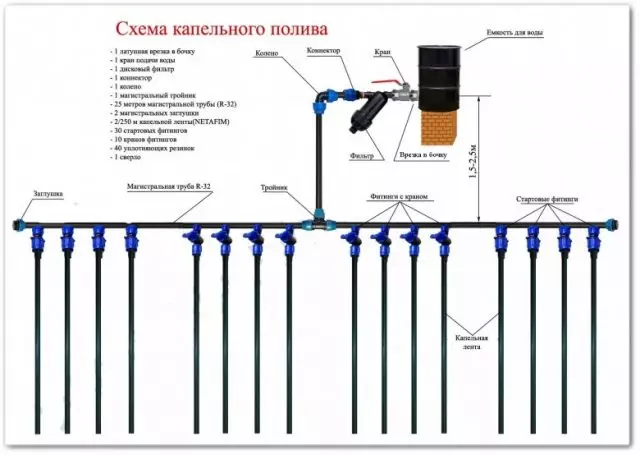
Drop irregulation scheme
Hoses for watering
For drip irrigation, hoses are produced that are manufactured with a length of 50-1000 m. These are pipes, in the labyrinths of which the liquid comes to plants through the holes.They are tough and soft. The operation time of hard tubes is about 10 years.
Soft ribbons serve no more than 4 seasons. They share:
- Thin-walled. Locked above the ground. Their thickness is 0.1-0.3 mm.
- Tolstown. There may be their gasket and underground. Have a thickness of 0.31-0.81 mm.
The inner diameter of the hoses varies in the range of 14-25 mm. Tapes - 12-22 mm.
Water consumption for hoses is up to 8 l / h. For thin-walled tapes 2.9 l / h, and thick-walled - 8 l / h. The installation step of droppers is 10-100 mm. It depends on the population of cultures.
Depending on the type of system, the operating pressure changes. With the sampling, it is 0.4 bar, and when using the pump, up to 14 bar increases. The size of watering is made such that water pressure is enough for extreme droppers. For hoses, this is 1500 m, and for tapes - 600 m.
Dropper
Droppers are used instead of ribbons. They are installed on the hoses. Their amount is formed in accordance with growing cultures.
They are divided into types:
- With normalized release.
- With adjustable.
Plastic housing is made. On the one hand, there is a fitting with a rubber ring. With it, a connection is underway with a hose.
Another kind of dropper:
- Compensated. The output of water from any point is the same.
- Noncompensated.
More trap "Spider", when. This is when several taps are connected. Near the arranged crops are water from one point.
Article on the topic: Picnic table do it yourself from an old ironing board
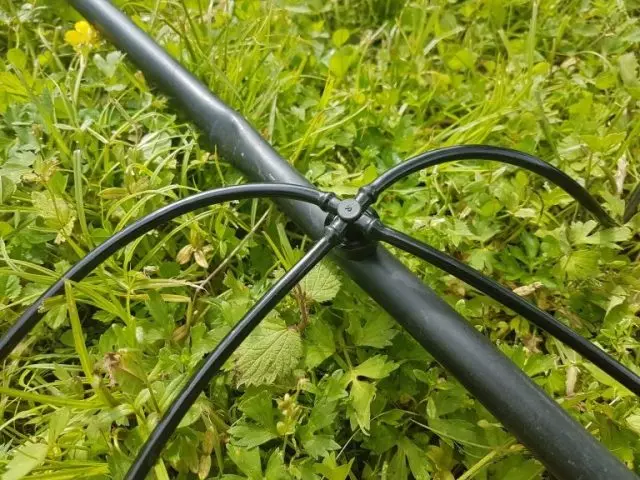
Dropper spider
Pipes and connecting elements
Pipelines are located on Earth. They have constant contact with water and chemical elements. Therefore, the manufacture of pipes and fittings is conducted from corrosion-resistant material. This is polypropylene, polyvinyl chloride or polyethylene. Pipes are high pressure and low.As adapters that connect the main pipeline with ribbon, tees are used. The fastening of them is carried out with the help of clamps. After a tee, a crane is installed. It overlaps if the plants are not required excess moisture.
The assembly of the entire system is possible with their own hands. However, there are assembled sets that can be immediately installed at the cottage.
System varieties
If we install a tank with water at a sufficient height, in the area of 1.5 m, then the need for pump disappears. Water will flow to go sick. The tank is filled in any way. It may be feed from the central system, manual fill or rainwater collection. The bottom is the crane that connects to the central highway.
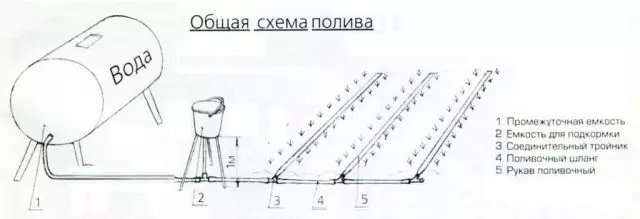
Drip System Self
If you need to make fertilizers, a node is connected to the central highway. This same container with a liquid solution. The hose and shut-off valve are inserted below.
Watering with shrubs and vegetable crops is conducted separate droppers. A separate tape is paved to the large tree, which is located in the ring around the trunk.
To enhance the pressure behind the tank, the pump is installed. In this case, a good pressure will be in the farthest droppers.
If you feed water directly from the source, bypassing the tank, the liquid will not have time to warm up. It will affect the growth of cultures.
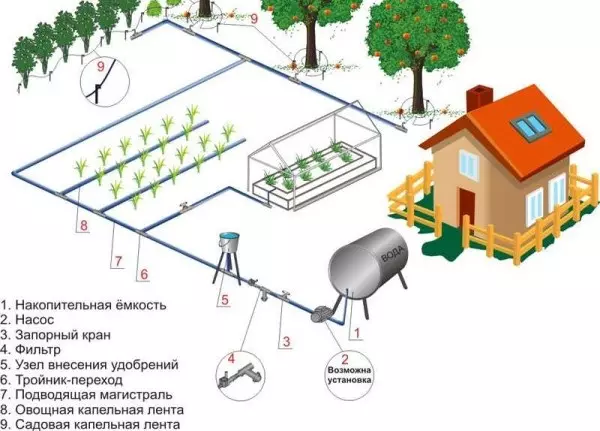
Drip system with pump and fertilizer
System calculation
The volume of the barrel is calculated, depending on the amount of plants of plants.The norm is presented in the table.
| Culture | Day water rate in liters |
|---|---|
| Vegetable culture | one |
| Bush | five |
| Wood | 10 |
To determine the volume of the barrel, the total number of cultures is summed. The amount is multiplied by the daily flow rate and add 25% of the stock. The length of the main pipeline is determined by measuring the distance from the tank before landing. The tapes are paved, correspond to the shortages of the bed. Depending on the number of branches, the same number requires tees, and the clamps are 3 times more.
When the water is supplied from the reservoir, 2 filters are installed: coarse and fine cleaning. If the fluid comes from the well or the central system, then the coarse cleaning is not required.
Article on the topic: Gate with the wicket of factory production: travel under protection
Homemade systems
For the organization of irrigation of the site with the lowest costs, you can use undergraduate materials.
This can be used objects, hoses of different diameters or plastic bottles.
Drip watering with your own hands can be done:
- From the hoses of different diameters.
- Droppers.
- Plastic bottles.
From different diameter of hoses
A large diameter shogg is carried out from the tank. He is brought to the place of landing. Through it, through the drilled hole, the hoses of a smaller diameter are inserted, in which the hole is pre-done. Through them, water comes individually to each plant. In this case, the dropper is absent. The liquid flows calmly.
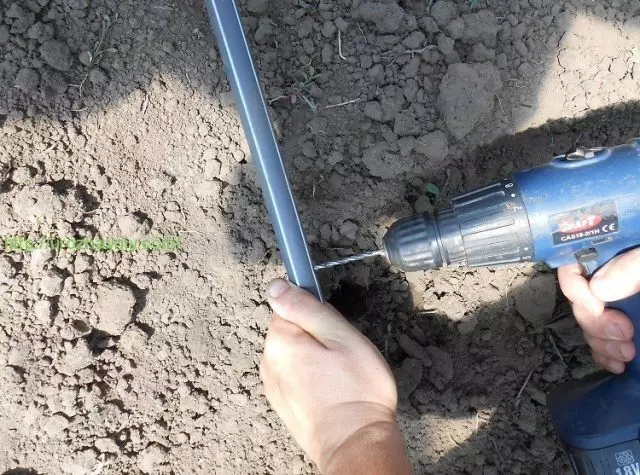
Drilling through hole where smaller diameter hose will be inserted
From droppers
If there is an opportunity to purchase former droppers, then the design is cheap. To do this, a hole is made in the center tube where the dropper is inserted. From it stretches the tube to the plant. It is possible to adjust watering with such a calculation so that the water flows the jet or compelled by drops.
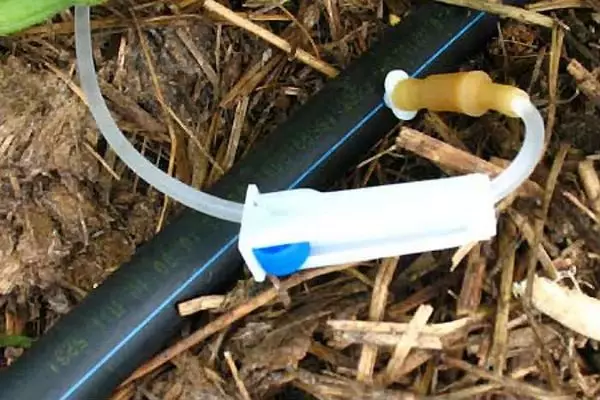
Drip watering through a dropper
From plastic bottles
This is the cheapest view of the drip watering. For this, the plastic bottle is taken and the bottom is cut off from it. At a distance of 7 mm from the neck, a small hole is drilled and a thin tube is inserted.
A bottle is tied to a peg over the plant and water is poured on top. Gradually, fluid flow through the tube. You can instead of a quieter over the garden pull the wire and bind a number of bottles to it. The main thing is that they hang over the root part of the plant.
Another option is to whip the bottle near the plant with the neck. The tube is directed under the root of the plant.
Sometimes the tube can not insert, water will flow through the hole. If you place a bottle down the bottom, then the water should be poured through the cover, and at the bottom to do the hole.
Drip watering from plastic bottles
In order to maintain the installation of drip irrigation in the country area, you need to prepare all the necessary materials. The assembly can be held with your own hands. To work without special costs, you should use the used material. The efficiency of the system will be the same, and the minimum attachments.
